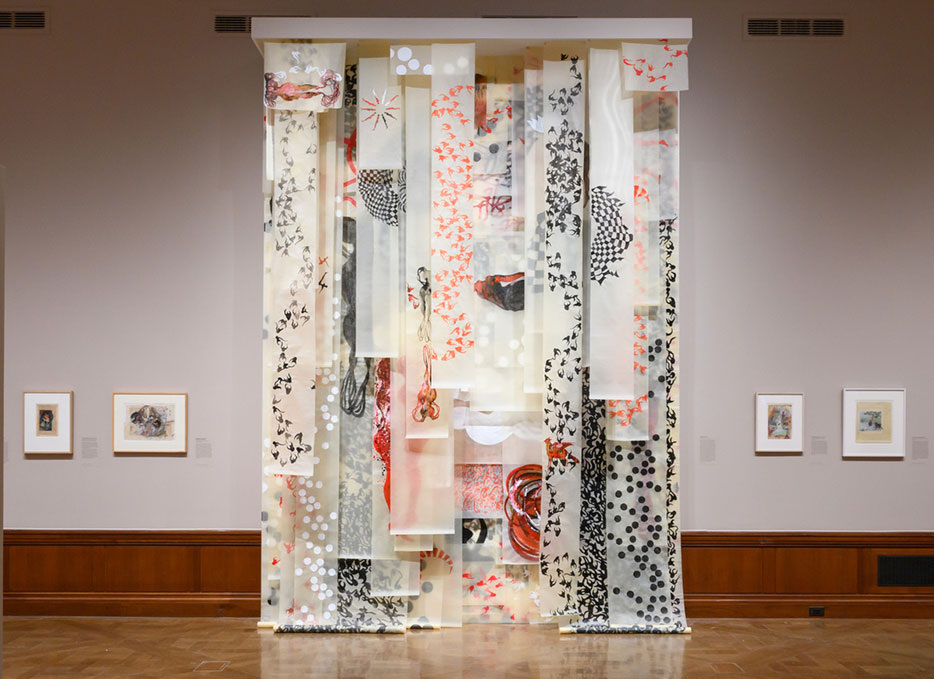On Shahzia Sikander’s Epistrophe
Maxwell Fertik
→MID 2023

Shahzia Sikander’s Epistrophe, 2021, magnifies Sikander’s iconography of culturally loaded forms, figures, and monstrous alter egos. It plays with scale and dimension like no other piece in Extraordinary Realities, her career survey show at the RISD Museum.
Epistrophe is a tableaux of dozens of tracing paper scrolls painted with ink and gouache and hung from the ceiling. Varying in length, most of these sheets are offcuts from earlier pieces which the artist made in the late 1990s and early 2000s, after completing an MFA in Painting and Printmaking at RISD. There are no borders, no bounds, and all marks are visible. The tableaux expands in every direction and presents an unstable, multivalent construction—a mural-sized vision of Sikander’s alternate realities.
The shortest scrolls hang closer to the ceiling, while others run the length to the floor, held down by the weight of still-rolled scrolls. Each parchment is dominated by single or oft-repeated motifs in reds, blacks, and whites over cream-colored paper. The motifs take a variety of forms: flowing parasitic shapes; unnervingly perfect dots; fractured checkerboards; headless feminine bodies made of wirelike roots; black legs obscured by the poetic motions of Arabic letters; circular formations of static bodies; black and white snakelike curls; and a red beast reminiscent of a griffin.
Unlike her miniatures, which recall those from the South Asian Mughal Empire (1528–1858) in their precision, this work projects a spontaneous multiplicity that pulls forward the figurative and fragmented bodies of the Other—an immigrant in America, alienated by nationalism and Islamophobia. Standing before the towering edifice, the viewer shrinks under a multivariate abstraction that, aided by air flow, takes form like a rising wave. Epistrophe is grounded by the scrolls that are enfolded with potential and curiosity. But the form brings the eyes upwards, from the floor going up past the different motifs and color combinations, right up to the ceiling in a transcendent movement.
Moving closer to observe individual scrolls, the viewer encounters a wealth of details. Three especially imposing scrolls demand attention. The first scroll hangs at mid-height and features two vertically mirrored, seemingly feminine bodies: one black and one red. Both evoke ceramic vessels that grow what the artist calls “self-nourishing roots,” in an interview published in the exhibition catalogue. This motif serves to recontextualize the feminine form by addressing misogyny and misrepresentation of women in art history. It presents a heterotopic view of the woman who not only refuses to conform to a given stereotype, but also self-generates, sheltering her identity by nourishing her own energy.
The second scroll falls all the way to the floor, held down by the weight of the rolled portion. Here, one witnesses a swirling mass of disembodied hair buns, reminiscent of those worn by Gopis or cowherd servants of the god Krishna in Hindu mythology. Alternatively, these new Gopis could be menacing, like flocks of crows, corrupting the traditional narrative of the Gopi as flirt. By becoming the Other and painting the ritual reproduction of this outburst of fragmentation and abundance, Sikander subverts alienation into an opportunity to exercise agency. Overlaid is an image of a red griffin, typically a Greek mythological creature, possessed by a chalawa or spirit who possesses animals in Pakistani folklore. This further emphasizes her drive to resist imposed stereotypes and to recontextualize representations in the West.
The third scroll, a short piece hung close to the ceiling, presents a circular pattern of bodies, neither male nor female, fluctuating in color and opacity. This pattern also appears in an earlier work titled Cholee Kay Peechay Kiya? Chunree Kay Neechay Kiya? (1997)—translated as “What's under the blouse? What's under the dress?”—which utilizes a queer logic that witnesses gender outside a traditional binary of secrecy and disclosure. Within this god-like incarnation that defies traditional gender binaries, one can witness the in-betweenness that Sikander’s work inhabits. Combining folklore and religious icons of South Asian cultures with contemporary stereotypes that accompany American nationalism, new modes of representation arise, resisting capture, resisting any one classification, resisting any clear, easy figuration.
The three chosen scrolls exemplify the vast anthology of Epistrophe. The first addresses misogyny and misrepresentation, the second, a resistance to imposed cultural stereotypes, and the third, a subversion of South Asian folklore that defies gender binaries. Each of the three scrolls embody the multiplicity of the work as a whole and magnify the many figures and icons seen in Sikander’s smaller, earlier works. The word “epistrophe” refers to the repetition of a certain word or phrase at the end of successive phrases to bring emphasis and poignancy to a sentence. And in this layering, repetition, and return to certain visual phrases of importance, we are provided an aesthetic epistrophe. At the center of Extraordinary Realities, Epistrophe recontextualizes lived experience with the complexities of cultural difference, reminding us that abstraction is never singular, alienation is never singular, in fact any form of representation is never singular, but rather these are all layers, accumulating into a state of self-generated glory.
Maxwell Fertik holds a BA in Art History and Sculpture from Trinity College in Connecticut. He has shown in group exhibitions in the USA, Spain, and Denmark. His work has been collected by Galleri Kai (Copenhagen, Denmark), and Watkinson Library at Trinity College.